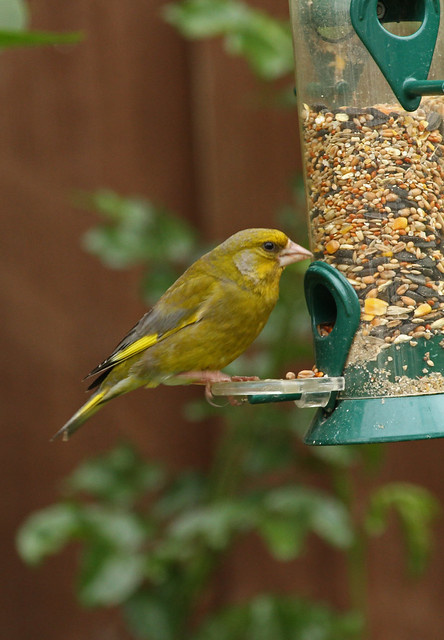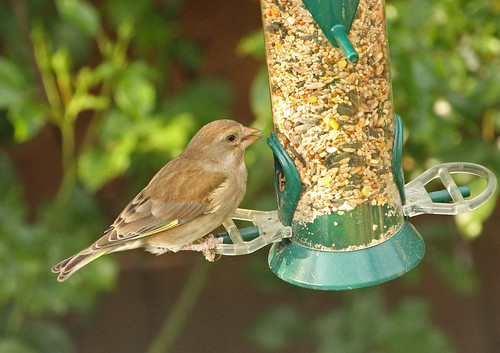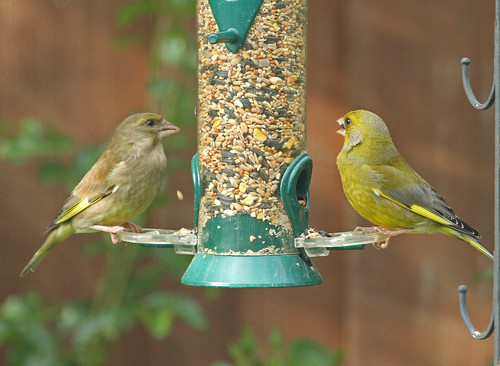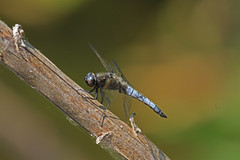Until a couple of years ago my garden bird feeders were always visited by lots of finches: chaffinch, goldfinch, greenfinch, even the occasional siskin. But then the goldfinch disappeared from the feeders, I didn’t see a single one for around 18 months, and then, even more bizarrely, the chaffinch stopped visiting. Greenfinch were always occasional visitors even though I could hear them in the nearby trees, but they seldom came in to feed.
I don’t know what caused the finches to change their habits but it made my garden rather less colourful.
 Goldfinch (Carduelis carduelis, Dansk: stillits) – a rare visit to the niger seed
Goldfinch (Carduelis carduelis, Dansk: stillits) – a rare visit to the niger seed
In the last year or so I’ve seen goldfinch on my TV aerial and regularly in the front garden around the pond, but they still tend to avoid the back garden even though there is always a feeder full of niger seed for them. I often see and hear both chaffinch and goldfinch in the nearby fields when I walk the dog, so they are still in the area, and chaffinch seemed just as common as ever… except in my garden. But goldfinch sightings increased over spring this year as did those of chaffinch:
 An erstwhile unusual visit from a male chaffinch (Fringilla coelebs, Dansk: bogfinke)
An erstwhile unusual visit from a male chaffinch (Fringilla coelebs, Dansk: bogfinke)
And along with chaffinch and goldfinch, greenfinch have also been visiting more frequently, and in springtime this year there were a family with a couple of young:
 Adult male greenfinch fuelling up (Chloris chloris, Dansk: grønirisk)
Adult male greenfinch fuelling up (Chloris chloris, Dansk: grønirisk)
And one of his fledged brood:
The male and a fledgling feeding together:
It’s a mystery why they moved away, maybe sparrowhawk visits became to frequent, or maybe because of recent warmer winters there is enough easily accessible food in the countryside. I stopped feeding the birds later in the spring because the seed was left uneaten and it began to go mouldy, but now the weather is getting cold I’m going to clean the feeders and refill them for the winter. And keep my fingers crossed the birds find them to their liking.






Good to hear from you again Finn, as to your question regarding fewer visits, sadly we cannot get inside these birds head but…. Like others I’d suggest it would be most likely down to some sort of disturbance i.e a ground predator like a Cat, a Fox or Badger visiting overnight could perhaps alter their routine in the first couple of hours of daylight, due to their scent. Has there been any increase in human disturbance next door or in the immediate vicinity, have you altered their roosting habitats or feeding area in any way? Alternatively there is the Raptor possibility, Sparrowhawk, a Tawny Owl even a Red Kite drifting by from time to time will greatly (albeit temporarily) increase their anxiety. Maybe it’s just simply an increase in food elsewhere. Still so many questions unanswered but ain’t that just part of the fun.
Kind Regards
Tony Powell and naturestimeline
Hello Tony, sure is – it just wouldn’t be interesting if we knew everything! There have been no major changes that I’m aware of with predators, avian or otherwise, and no significant changes in human activity, so I think the most likely explanation is that they’re finding more food in the countryside. But it would be good to have them back.
Finches are ground feeders. My suggestion is that you have an invader cat :(.
You could be right, but I haven’t noticed extra cat activity. I reckon the most likely reason is the weather, the last two winters have been very mild compared to the three before that were unusually cold, and then lots more birds of all types came to the garden.
HI Finn
You found me!! Our group moved to the Sanger Institute in May. My new e-mail address is ec13@sanger.ac.uk
Do pass it on to Andrea, also please tell her to join us for Cantab Girls meeting sometimes.
We are all fine this end, looking forward to a break at Christmas. Hope you are all well and happy.
Take care
Esther
Hello Esther, will pass on your email to Andrea. Fine at this end and glad to hear all’s well with you. All the best. F
Hope they frequent your feeders again. It’s always a joy to see wild birds close up and know that they’re benefitting by the winter seed supplies.
The weather has been highly unseasonal so far this year with temperatures being generally in the teens , so if it stays like that the birds may not need to reappear in the garden. So I’m hoping for some proper winter weather in the near future… Climate change? Feels like it could be.
Climate change certainly, but In Melbourne the weather is so weird and unpredictable. One day very hot and humid and the next cold & rainy like mid winter. Superb day yesterday at the start of my Zoo excursion and by the time I left It looked like thunderstorms and was cold wind again.
Hello Vicki, has the Melbourne weather always been so unpredictable? That aspect of our climate here in Cambridge definitely seems to me to have changed over the last 10 years or so.
Nice to have them back, and nice to have you back, too. 🙂 I’ve noticed a lot of bird activity in my garden lately, particularly house sparrows which are appearing in larger numbers. Now that you mention it, however, there is a distinct lack of chaffinches. There are blue tits, coal tits, dunnocks, robins, wrens, occasional long-tailed tits and woodpeckers, but very few chaffinches. I wonder why that is, I’ll have to keep an eye out over the winter and see if they reappear. One of the nice things about the cold weather is that it brings rarely seen birds to the feeders. I saw a goldcrest and a bullfinch yesterday, both of which fairly brightened my day. You seem to get far more greenfinches than we do up here, I don’t often see them.
Thanks Lorna. Did you get bullfinch and goldcrest in your garden? That’s impressive!
They’re two of the species that I had never got good photographs of before this weekend. I was at a place called Ouse Fen near St Ives in Cambridgeshire and it was full of songbirds including more bullfinch and goldcrest than I’ve seen for years… and I got pictures… to follow in a post very soon.
I look forward to seeing your photos, Finn. Yes, both bullfinch and goldcrest were in the garden, just one of each. I also saw a treecreeper the other day which is something I only see now and then.
Wow! That’s really cool. I’ve got garden envy. Do you live near woodland? I rarely see treecreeper and I’ve never seen one in the village.
There is some woodland nearby, and there’s also a large house whose garden joins onto this property. Right outside my bedroom window is the entrance to the house, where there’s an enormous sycamore tree. It’s that tree where I usually see treecreepers, although I have also seen them on our lilac bush. I have a great vantage point from my bedroom window because just along from the sycamore are some tall pine trees that red squirrels enjoy leaping about in. Buzzards and crows also nest there so it’s quite a wildlife theatre.
Drama indeed. Your window sounds a perfect vantage point.
We have a niger seed feeder as well, but we get only the occasional visit from migrating goldfinches and juncos. The only relatively common ones are the chickadees, and they seem to be not as interested as they once were. It’s sad to see so few. With winter rapidly approaching, I plan to empty out the feeder, clean it thoroughly, and restock it with fresh seed. Hopefully that will help.
The cold winter weather drives many of my local bird species to the feeders in the garden which would normally take care of themselves in the countryside. And I guess it’s the same in your neck of the woods so I hope your feeders are full this winter!
You are lucky to have these birds back even at low numbers. When I moved to my present house 20 years ago, Greenfinches were probably the commonest garden bird. No longer – see below. The removal of nearby mature trees had a general impact for a few years but now I get big numbers of sparrows and a reasonable variety of other birds, but any finches are very rare.
We know that Greenfinch numbers were badly affected by trichomonosis from 2006 on, see: http://www.bto.org/volunteer-surveys/gbw/gardens-wildlife/garden-birds/disease/trichomonosis. Some parts of UK have recovered to some extent, others have not. My garden has had one brief sighting of a male-female pair of greenfinches this year (the first such sighting since 2006), but they didn’t stay.
There is strong suspicion that this disease was spread by gatherings of birds at garden feeding areas. It is therefore essential to thoroughly clear
n feeders every time you refill, and I take them apart and disinfect about once a week. I also move feeders around the garden but as it’s a small garden, this isn’t easy. Mouldy food can cause other problems for birds and should always be discarded immediately (for same reason, don’t throw bread to ducks on ponds). You can readily find more detailed advice on-line.
I’m hoping they come back in normal numbers over the winter, I’ve got established trees all around and am on the edge of the countryside so they just need to find me again. There are still greenfinch around and about here in good numbers so I don’t think trichomonosis is to blame so that’s why I wonder if predators (sparrowhawks, cats etc) may have had an influence. But I’ll get the feeders cleaned and filled and report what I see over the winter.